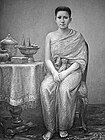Panung

The panung or pha nung (Thai: ผ้านุ่ง, RTGS: pha nung, pronounced [pʰâː nûŋ]) is a lower attire worn by individuals from Siam.
Style
Panung is a traditional garment worn in Thailand.[1] It is a long strip of cloth, described in 1921 by the US vice-consul as "a piece of cotton cloth 3 by 10 feet"[1] is wrapped around the waist, reaching below the knees. The cloth is sometimes passed between the legs and tucked at the back[2] in a fashion known as chong kraben. The garment is normally paired with a sabai or pha hom, a similar cloth used to cover the upper body.[1]
Variations
Panung is a versatile garment that can be worn by anyone, regardless of gender. It is available in different qualities, with first quality being Patta. Patta is a durable printed cloth that features bold check patterns or with cross designed patterns. It is possible for this item to have one or more stripes at either end.[3] The second quality is Papoon, characterized by fast coloration and the narrow stripes woven into the cloth.[3] It is also woven with a two-and-two checking pattern.[4] The third quality is known as Palai, which refers to proper sizing of materials and a stiffened structure.[3]
Contemporary Western clothing is moving away from the traditional Panung style of dressing.[5]
Images
- Queen Somanass Waddhanawathy, a first queen of King Mongkut (Rama IV) wearing pha nung and pha biang
- Queen Savang Vadhana, a consort of King Chulalongkorn (Rama V) wearing pha nung and pha biang, in 1879
- Thai children wearing pha nung and pha biang
See also
References
- ^ a b c Hansen, Carl C (11 April 1921). "Market for Ready-Made Clothing in Siam". Commerce Reports. 2 (83). Bureau of Foreign and Domestic Commerce, Department of Commerce: 226.
- ^ "panung | Definition of panung in English by Oxford Dictionaries". Oxford Dictionaries | English. Archived from the original on July 25, 2018. Retrieved 2018-07-24.
- ^ a b c Commerce Reports. Bureau of Foreign and Domestic Commerce, Department of Commerce. 1915. p. 574.
- ^ "The Project Gutenberg eBook of Piece Goods Manual, by A. E. Blanco". www.gutenberg.org. Retrieved 2023-08-13.
- ^ The Journal of the Siam Society. The Society. 1951. p. 218.









